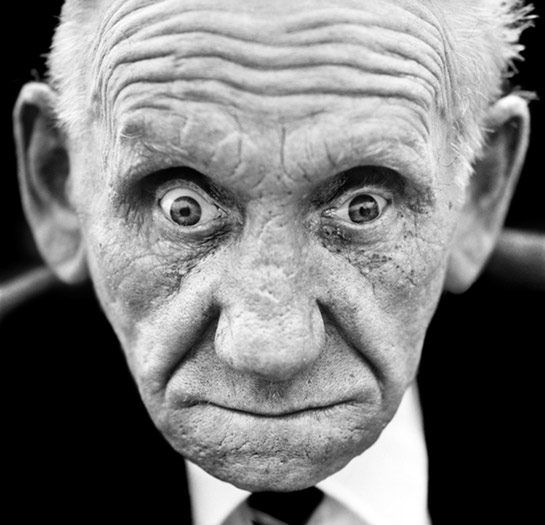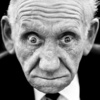Meditations on Photographs: Frederick Lennart Bentley by Martin Roemers

“The face,” Cicero (106-43 B.C.) is supposed to have said, “is a picture of the mind as the eyes are its interpreter” (“Ut imago est animi voltus sic indices oculi”), and we know this as “the eyes are the window to the soul.” Scientists, oddly, seem to agree. And this is all fine, except that we have a problem here. What about the blind? Ordinarily, I don’t take those kinds of expressions for more than what they are. In particular, I try to avoid them in my writing, fighting my own hopeless war against cliché (in all likelihood a much paler version of the original one). But I saw this particular photography, a portrait of Frederick Lennart Bentley, taken by Martin Roemers and part of his The Eyes of War (which I reviewed here), and that’s the first thing that came to my mind (which, apparently and much to my consternation, is quite content with cliché). Click on the image on the side to see it fill your screen. (more)
Why is this such an impressive photograph, certainly one of the most impressive ones from that body of work? First of all, there is the seeming aggressiveness in the facial expression. The lowered jaw, protecting the vulnerable throat, the washboard-rippled forehead, the mouth just a line, the eyes wide open - this is one of the quintessential aggressive poses. But it does not take long for something else to appear. Or maybe the message pops out of focus - much like slides (remember those?), when projected, often popped out of focus once the heat from the lamp made them move towards (or away from) the projector’s lens. Pop! Something is not quite right. What are are these eyes looking at? Are they looking at something? At anything? Given we know that they don’t look at, in fact, anything, that they’re blind, things turn upside down for us. What are we going to make of this now?
As it turns out, a subject’s eyes play an important role in photography. I wrote about the almost dead eyes of a mother, posing for a portrait with her daughter. There, life seems to have drained from each and every part of the old woman’s body. It’s a shell, held in place, awkwardly and pained, by the daughter. I wrote about a man whose eyes seem to be piercing us from the surface of the photograph. Here, it is almost as if we were unable to move, as if we were the ones being held in place. And now there are these eyes, a combination, if you will, of those two: Frederick Lennart Bentley is very much alive, but his dead eyes appear to be almost piercing us.
Before they were blinded, these eyes in all likelihood saw things many of us cannot imagine. Bently was a soldier during World War 2, and he had to live in darkness ever since. The photograph itself does not tell us that, but the context, the book, does. So we attach meaning, we attach readings, because that is what we do. Meaning and readings are like lint that is attracted by photography, to stick to it, like cat hair sticks to a black dress. Calling readings of a photograph lint is somewhat unfair, but often enough, it is apt, especially once we’re engaged in the often extremely shallow readings of photographs in the realm of the news. Brush as you might, some lint just won’t come off. But that’s OK - as long as we’re aware of what to do, as long as we realize the what matters is the black dress, the photograph in question, not the lint.
In a review of Lick Creek Line by Ron Jude, I spoke of the two modes of photography, the one attaching right to one’s nervous system and the other one, generated by the part of the brain we like to think of as being under our control. There is a small gap here, both in time, but also, ultimately, in the meaning (I told you meaning was like lint, you just can’t get away from it). The power of many photographs lies exactly in that gap, that delay, that hesitation that might result from not being able to know how to process after having had the first, initial reaction. The broader that gap, the less certain we are about a photograph, the more enticing it becomes. Frederick Lennart Bentley, the photograph, operates in that gap, through that gap. You think you know, and then you don’t. You find out why you don’t know and what you need to know instead. But once you look at the photograph again, you’re being thrown back to an earlier stage, almost to the moment when you first saw this portrait. The moment you try to clarify things, the moment you really try to nail the damn thing to the wall, a wall, anything that might give it stability, certainty… everything deflates.
In the case of this photograph, the viewer simply has to resist the temptation to know too much, to decide too much, to categorize too much. This is also photography: Created with the help of a machine, it lodges itself somewhere where we’re most vulnerable - right in between our desire and our understanding of the world.
photo: © Martin Roemers, Frederick Lennart Bentley, from The Eyes of War; kindly provided by the photographer - thank you!
 By
By 